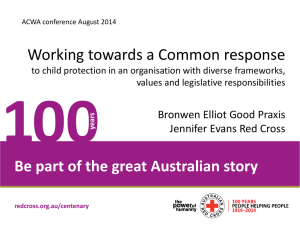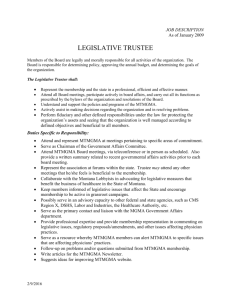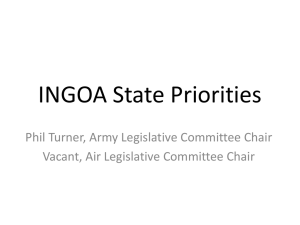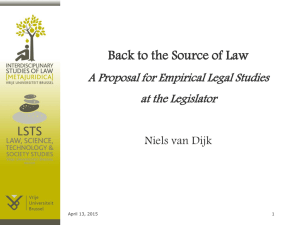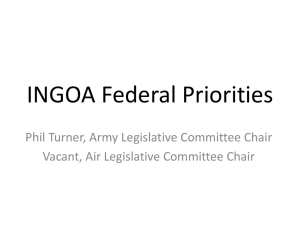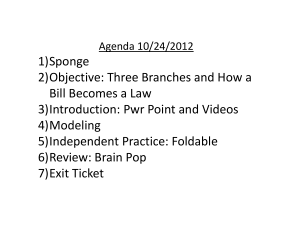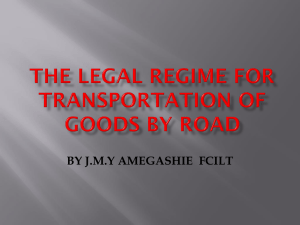Achieving river integrity through NRM and ICM
advertisement
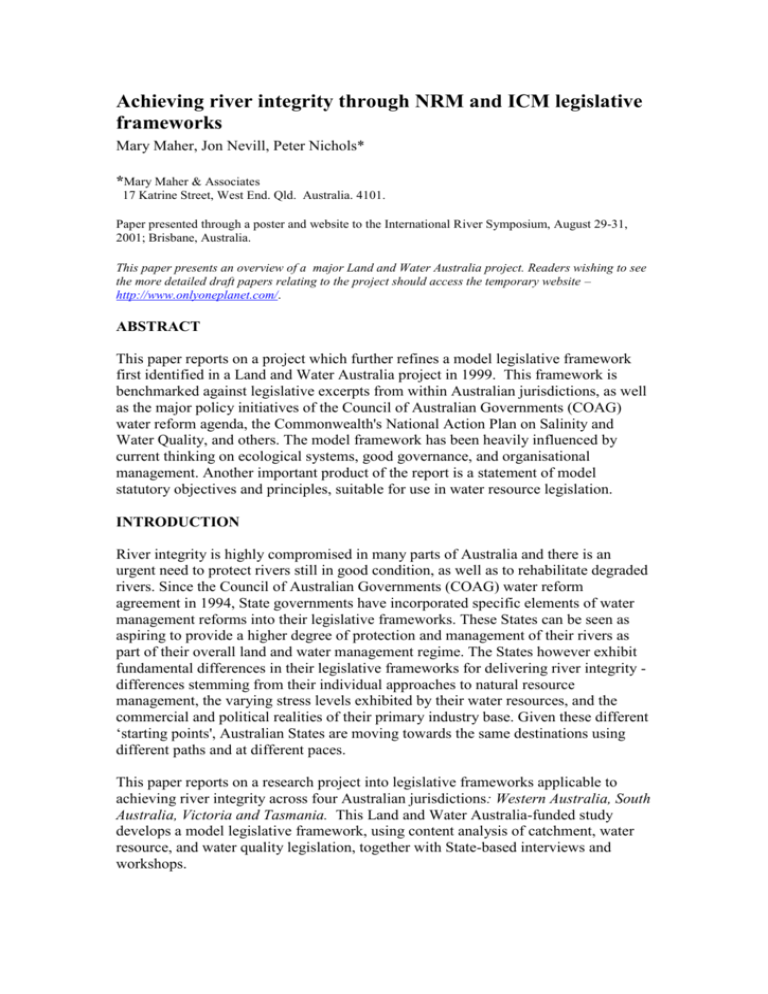
Achieving river integrity through NRM and ICM legislative frameworks Mary Maher, Jon Nevill, Peter Nichols* *Mary Maher & Associates 17 Katrine Street, West End. Qld. Australia. 4101. Paper presented through a poster and website to the International River Symposium, August 29-31, 2001; Brisbane, Australia. This paper presents an overview of a major Land and Water Australia project. Readers wishing to see the more detailed draft papers relating to the project should access the temporary website – http://www.onlyoneplanet.com/. ABSTRACT This paper reports on a project which further refines a model legislative framework first identified in a Land and Water Australia project in 1999. This framework is benchmarked against legislative excerpts from within Australian jurisdictions, as well as the major policy initiatives of the Council of Australian Governments (COAG) water reform agenda, the Commonwealth's National Action Plan on Salinity and Water Quality, and others. The model framework has been heavily influenced by current thinking on ecological systems, good governance, and organisational management. Another important product of the report is a statement of model statutory objectives and principles, suitable for use in water resource legislation. INTRODUCTION River integrity is highly compromised in many parts of Australia and there is an urgent need to protect rivers still in good condition, as well as to rehabilitate degraded rivers. Since the Council of Australian Governments (COAG) water reform agreement in 1994, State governments have incorporated specific elements of water management reforms into their legislative frameworks. These States can be seen as aspiring to provide a higher degree of protection and management of their rivers as part of their overall land and water management regime. The States however exhibit fundamental differences in their legislative frameworks for delivering river integrity differences stemming from their individual approaches to natural resource management, the varying stress levels exhibited by their water resources, and the commercial and political realities of their primary industry base. Given these different ‘starting points', Australian States are moving towards the same destinations using different paths and at different paces. This paper reports on a research project into legislative frameworks applicable to achieving river integrity across four Australian jurisdictions: Western Australia, South Australia, Victoria and Tasmania. This Land and Water Australia-funded study develops a model legislative framework, using content analysis of catchment, water resource, and water quality legislation, together with State-based interviews and workshops. The key elements of such a model framework are scoped and elaborated upon through the use of excerpts of legislation from within the participating jurisdictions. At this point, the model framework provides a tool for debate. It poses a challenge for those States who perceive legislative frameworks as being of limited value. It also provides a benchmark for States with a demonstrated commitment to a strong legislative framework and which are moving into the second generation of legislation geared more to target-based and regionalised natural resource management outcomes. The model framework serves several functions. It is intended to: Provide a comprehensive conceptual model to stimulate debate amongst policy makers and key stakeholders concerning: the full range of functions afforded by legislation its best use in complimenting the suite of management tools available; Enable comparisons with alternative (non-statutory) approaches to management; Scope those integrated management processes which have the potential implementation through legislation; Enable evaluation of management options for example, the scope and variety of institutional arrangements; Provide a recognised framework for specific processes - for example, for reporting and evaluation exercises; and Initiate development of criteria for benchmarking of legislation between and within States. The model framework is not intended to promote a ‘one size fits’ all approach to legislative design; nor is the intention to communicate that elements of legislation can be bolted onto existing frameworks. The model framework serves as a vehicle to highlight key similarities and differences between State approaches, and for examination of the more universal issues inherent in State efforts to build more effective management frameworks to deliver greater river integrity. KEY PRINCIPLES The concept of the model arises from a merging of ecological systems thinking, good governance principles, and management systems thinking. Key principles underlying the Model Framework are outlined in Table 1 below. Table 1 Principles underlying the model framework Ecological Systems Economic progress works within: ecological and social limits ecological uncertainty constancy of change, and innovation basis of no net loss of ecological assets – give and take, that taking involves Good Governance Participation Transparency Certainty Accountability Integrity Cost-effectiveness Flexibility Management Systems Adaptive management: plan, do, monitor, report, review, revise continuous improvement; producer responsibility: responsibilities remain, constant SWOT analysis process of reporting on their achievement; giving back success goes to those who compete best on providing sustainable management; short-term economic gains weighed up from a longterm social and ecological perspective. Practicality strategic planning for complex issues; coordination and clear definition of their roles and responsibilities for outcomes. 'River restoration' and 'management' are defined in their broadest sense. The two terms include protection of rivers in their wild or natural state, as well as the full range of actions associated with sustainable use and rehabilitation of Australian rivers. In this project, ‘river management’ or ‘river integrity management’ are used as referring to the ongoing process which achieves a stated objective or condition for a river; and ‘river restoration’, to an improved condition of the river. River restoration is the restoration of the bed, banks and river ecosystem that requires management of any impacting activity within the spatial unit of the catchment and / or interlinked aquifer. This idea of restoration to an earlier state (an earlier state of 'naturalness') requires a prior condition to be defined as the objective for the restoration, perhaps by reference to the condition at a specified date. Catchment management is considered the vehicle for achieving a range of natural resource management outcomes, including but not limited to river management and restoration. River integrity outcomes are dependent on effective catchment management and these concepts are used interchangeably in this report. THE ROLE OF LEGISLATION The project brief assumes legislative change may not be easy or frequent, but that acting to manage rivers without legislation is a limited approach. This study expands on this with the following understandings: Legislation is not separate from community enthusiasm, political commitment, adequate resourcing. Legislation need not be preliminary to these factors, nor predominate over them. There are examples where legislative frameworks have had the leading role in delivery of river management particularly in terms of specifying government commitment and structures for enabling accountable plans and implementation structures; The downside of legislation in some jurisdictions is that it is slow to develop, cumbersome to change, sanitised for political acceptance at the last minute, onerous to service and lacking in resources for enforcement. Legislation can be oppositional, obstructive and even irrelevant. States differ, and key players within a State also differ, in their view of the role which is most appropriate for legislation to play in achieving the goals defined either within that jurisdiction for water management and / or in relation to the national agenda for water management. Legislation may play its role centre stage or back stage; from a high profile role of actively assisting or even requiring catchment management through to a low profile role of not hindering voluntary initiatives efforts for catchment management. It is acknowledged that there are different pathways to delivering river management. It is not about having one framework and one point in time but about changes in each State leading towards achieving the desired degree of protection and sustainable use, and how these changes are generated, directed and evaluated. Legislation results from forces that are both universal and context-dependent. It is evolved within, as well as imposed upon a jurisdiction; it usually results from a degree of learning from other jurisdictions as well as from assessing the aspirations and political sensitivities within a jurisdiction. The degree of crisis about a natural resource issue then will play a substantial role in defining the scope of the legislative provisions and their degree of command and control. Legislation can be introduced overnight or it can be an extensive 5 year gestation including policy discussion papers, consultation, using the approach that there will be no regulation without participation. The project team’s view in summary is that if river managers are highly talented and committed; if ‘local champions’ are well spaced across the network of players and politically, legally and financially empowered; if all spheres of government invest in open and honest exchange to prepare plans and programs and agreements for timely implementation; if the business and community sectors feel optimistic about the prospects and purpose of engaging in river management, and if there is a learning community approach to the science underpinning the planning and management process, then maybe the need for a comprehensive legislative framework for river management is less pressing. Then again, all this can be enhanced and facilitated, but not replaced by, a good legislative framework. PROJECT METHODOLOGY Over the last decade water resource management and river crises have moved to a higher place on the agenda of regional and national development. The project sought to identify legislative coverage of those components which participating practitioners considered should be part of an ideal water management legal framework. This analysis has enabled a set of conclusions to be drawn up for each participating State. Naturally, the components differ as different States have used different approaches in developing water management laws and water management policies. Those laws have moved a considerable degree in recent years. Some States may still have uncertainty not only about the effectiveness of those recent changes, but even about their interpretation, application and integration. There are different strengths between the “silos” or functional agencies of different States, different local cultures, and different political attitudes as to the way and manner in which legislation might be applied in practice (and all these are unlikely to be constant even over the short term). THE MODEL LEGISLATIVE FRAMEWORK Accordingly we propose the fourteen elements of the model (together with their subelements) set out below as an appropriate basis for a best-practice framework for river / water management legislation in Australian jurisdictions. The model has been derived from the analysis required by the NRC project brief: a detailed analysis of existing Australian legislation against best practice criteria, to develop a suite of general principles, approaches and specific clauses that could be used by governments and statutory bodies to provide a sound legal basis for actions in the sustainable management of rivers and water resources; examining how this is expressed in regulation, planning and permitting powers and other means that directly influence riverine and water resource development and management. as for legislation, identify best practice and examples of these aspects; and Undertake these tasks in close collaboration with State agencies and statutory bodies such as Catchment Management Authorities. Table 2: Model legislative framework 1 2 3 4 5 6 7 8 9 10 11 12 13 14 Definition of a river Binding standards for river integrity Primacy of catchment legislation Hierarchical planning and management structures Catchment-based custodial agency Stakeholder-based structures and public involvement Coordinated planning and implementation Capacity to self-fund Engagement of local government Requirement for continuous improvement Custodial agency as catchment investment coordinator Licensing, compliance and enforcement Required independent audit and reporting Sequential and flexible dispute resolution mechanisms Subelements of the framework These fourteen elements are then elaborated upon through 81 sub-elements. A sample of element 5 and its sub-elements is presented below. Table 3: Element 5 - Catchment-based custodial agency Sub-element 5a. The custodial catchment-based agency must be charged with developing a statutory strategic plan (within a specified timeframe) to ensure the protection, management of sustainable use, and restoration of the catchment. 5b. The strategic plan needs to be comprehensive (all NRM issues impacting on river integrity) and must meet national and State strategic requirements. 5c A review period for the strategic plan should be mandated; as also should be the maximum time period for those reviews necessary to bring the strategic plan within any new Commonwealth or State strategic requirements. 5d An Independent Expert Panel mechanism is to be utilised in instances where there is disagreement, for example about sustainable water extraction limits. 5e. Catchment strategies should be implemented utilising incentive mechanisms such as rate rebates or tied grants wherever practicable. 5f. The catchment agency must be able to ensure agreed river management objectives take precedence over sectoral / local objectives. 5g. Catchment strategies are to recognise and protect freshwater ecosystems of high ecological or representative value. BENCHMARKING THE MODEL FRAMEWORK Finally the model legislative framework is benchmarked against national-level initiatives for improving river management, specifically: the key elements of the Council of Australia Government’s water reform framework of 1994; the key elements of the National Action Plan for Salinity and Water Quality of 2000; the recommendations of the House of Representatives’ Standing Committee on Environment and Heritage’s Report on Coordinating Catchment Management (2000), and given the interest and focus on institutional arrangements and partnership mechanisms in all States, the model framework is also benchmarked against key criteria noted in the literature on these aspects of effective catchment management. CONCLUSION One ongoing issue for this project is no doubt the non-participation of two key States, Queensland and New South Wales, together with the two Territories. No attempt has been made in this project’s timeframe to examine their respective legislative frameworks or to incorporate examples from these, except where relevant information was already in hand. The absence of information on New Zealand resource management legislation, and their regional catchment-based government structures, also represents a major limitation to the study. It is recognised that this is a model applicable to the longer term. Not all its elements and sub-elements may be achievable in full in the next phase of water legislation reform. The model has also to be evaluated and possibly expanded in response to further consideration of its social and economic impacts. We consider the post-COAG 1994 water legislative changes, which have recently taken place in all Australian jurisdictions as the first phase in legislative reform aimed at achieving sustainable water management in Australia. Although we envisage that the reform of water management frameworks will be an ongoing process over the next several decades, the next few years are likely to be a critical period. Freshwater ecosystems are in general decline, and decisive action is needed to reverse this situation. Ms Mary Maher Mary Maher, BA; Dip Ed. Uni Qld; M.Env.Sc; M.Tech.Sc. Griffiths Uni. As an environmental planning consultant, Mary has over 25 years professional experience in environmental management. Consultancy work to date has involved work for Commonwealth, State and Local Governments looking at planning and management of coastal, forest and riverine ecosystems as well as legislative reviews, state of environment reporting and evaluation of programs aimed at ecosystem protection. Major projects have included review of the regulatory framework of the Brisbane River, an education plan for protection of shorebirds in Moreton Bay, a training program for Environment Australia's Wetlands Unit in Environmental Impact Assessment processes and techniques, as well as a nation-wide review of legislation for rivers - their protection, restoration and management. Mr Jon Nevill Jon Nevill: B.A.; B.E.(Mech)Hons; M.Env.Sc. Jon Nevill is an environmental scientist and planner with extensive experience in the water industry. He has previously published over 30 short papers and co-authored three books (two dealing specifically with the water industry). In addition to his work as an independent consultant, Jon has held senior positions in environment agencies in Queensland, New South Wales, Victoria and Tasmania. His experience in the water industry includes strategy development, environmental impact assessment, policy implementation, and the management of sewerage programs. He is currently a Director of the environmental consultancy Only One Planet. Peter Nichols Peter Nichols, BA (Hons), Cert (Environmental Planning), Grad.Cert Applied Science (Ornithology), offers services to governments and those who deal with them, whether as individuals, community groups, special interest groups, advocacy and industry bodies or other levels of government. These services focus on policy, strategic and operational aspects of ecological, environmental and natural resource management, and on ornithological aspects.
